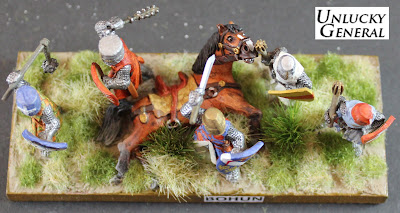Identifying the Rebels
When it comes to identifying the Rebels, and I'm really talking about the knights, I have been presented with a number of problems. The first is that such a list does not appear to exist. This is most probably because no one until now (ie: me) required one. After all, who but a wargamer, attempting to represent a battle visually with as much accuracy as possible, would need to identify individual knights present on the fieled of Lewes?
The list which follows is a work in progress and stems from my research into secondary sources as well as an examination of chronicles, the Fine Rolls of Henry III for the years 1263 and 1264 (available now on line) and the Patent Rolls of the same years made available on line by the Iowa University Library. Perhaps obvious to the wargamer, it is not enough to identify a knight named as a Rebel. Identified Rebel knights also need to have an identifiable blazon or shield device in order for me to paint a corresponding figure and depict that person in the army. For a representative ration of 1:20, you'd think that such a task would be simple enough but not so.
In a perfect world I'd have been able to identify sufficient knights as both rebels and present at Lewes. In order for me to make my list I have had to make certain assumptions or more precicesly conjectures as to the combative nature of a knight identified as in rebellion against the King and often their presence at Lewes on the day of battle. For example, I identified rebel knights through the fine rolls who are clearly stated as having broken the king's peace whereas in certain cases they are identified in the Patent rolls where they have been ordered by the king to surrender possessions (town or castles) to loyal knights due to those possession having fallen into their hand due to the rebellion. Once their condition or status of rebel can be comfortably maintained I then have to surmise their capacity to bear arms and their presence at Lewes.
All of my unit and ward commanders are recorded by the chroniclers as having been present ... so no dramas there then. Of the rest of my rebel knights only about 1/10th are recorded as such and such is life.
The list which follows is a work in progress and stems from my research into secondary sources as well as an examination of chronicles, the Fine Rolls of Henry III for the years 1263 and 1264 (available now on line) and the Patent Rolls of the same years made available on line by the Iowa University Library. Perhaps obvious to the wargamer, it is not enough to identify a knight named as a Rebel. Identified Rebel knights also need to have an identifiable blazon or shield device in order for me to paint a corresponding figure and depict that person in the army. For a representative ration of 1:20, you'd think that such a task would be simple enough but not so.
In a perfect world I'd have been able to identify sufficient knights as both rebels and present at Lewes. In order for me to make my list I have had to make certain assumptions or more precicesly conjectures as to the combative nature of a knight identified as in rebellion against the King and often their presence at Lewes on the day of battle. For example, I identified rebel knights through the fine rolls who are clearly stated as having broken the king's peace whereas in certain cases they are identified in the Patent rolls where they have been ordered by the king to surrender possessions (town or castles) to loyal knights due to those possession having fallen into their hand due to the rebellion. Once their condition or status of rebel can be comfortably maintained I then have to surmise their capacity to bear arms and their presence at Lewes.
All of my unit and ward commanders are recorded by the chroniclers as having been present ... so no dramas there then. Of the rest of my rebel knights only about 1/10th are recorded as such and such is life.



Comments
I have on my list
Rebel barons
Simon de Montfort Earl of Leicester
Henry de Montfort
Guy De Montfort
John de Burgh
Gilbert de Clare (the red)(8th earl of Glouster)(lord of Glamorgan)
Thomas de Clare
John Fitz John
William de Montchensy
Nicholas de Seagrave
Henry de Hastings
John Giffard
Henry de Borham
Sir John Beavs
Ralph Basset
John Beauchamp
William de Mandeville
Hugh de Despenser (earl of Premboke)
John Le Despencer
Rodger Le Despenser
William Le Blound
Humphrey de Bohun
John de Burgh,
Robert de Ros
Geoffrey de Lucy
John de Vesey
Richard de Vipont
Simon junior de Montfort, Peter de Montfort, Adam of Newmarch, Baldwin Wake, William Marshall, had been captured at Northampton;
William Bardolf was at Nottingham Castle.
Richard de Grey was holding Dover Castle.
Nothing is known as to the whereabouts of Walter de Colville and Robert de Toeny.
Reginald de Grey (holding the coast?)
Stephen Bersted (?)
Robert de Ferres (earl of Derby)
John de Eyvill?
http://www.earlyblazon.com/ battle of Lewes
cheers
matt